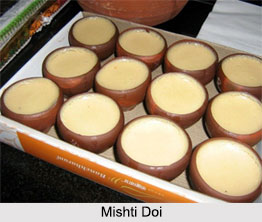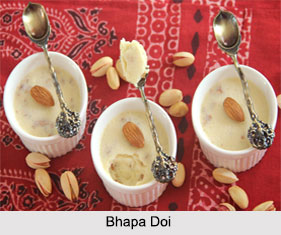 Mishti Doi is a traditional Bengali dessert of delicately sweetened curd. Mishti Doi is a fermented sweet curd mostly consumed in the states of West Bengal and Odisha in India. This dish is extremely popular among the Bengalis. Milk and sugar are the basic ingredients for preparing Mishti Doi. This is easy to prepare and can be made at home.
Mishti Doi is a traditional Bengali dessert of delicately sweetened curd. Mishti Doi is a fermented sweet curd mostly consumed in the states of West Bengal and Odisha in India. This dish is extremely popular among the Bengalis. Milk and sugar are the basic ingredients for preparing Mishti Doi. This is easy to prepare and can be made at home.
Mishti Doi is generally consumed as a single food item but sometimes people prefer to have it with puffed rice or Poha. Curd is considered auspicious in Hindu religion hence this dish is also made in various occasions and celebrations like Durga Puja, Diwali and weddings.
Ingredients for Mishti Doi:
•Full Cream Milk - 1 litre
•Sugar - 1 and 1/2 cups
•Water - 2 to 3 tbsp
•Fresh Curd - 3/4 tbsp
Method:
•Put the milk to boil with 1 cup sugar.
•Bring to boil and further boil for 7-8 minutes.
•Meanwhile put remaining sugar in a heavy saucepan. Heat on high, stirring continuously till brown like caramel.
•Add water and stir well till boil is resumed.
•Add to the boiling milk and stir well. Boil for a further 5-7 minutes. Cool till warm.
•Add curds and stir.
•Either pour into individual cups or a single vessel.
•Cover with lids or lid.
•Keep in a warm, dark, dry place to set.
•Let the Mishti Doi set in a warm place for few hours. When set, store in refrigerator and serve chilled.
 Bhapa Doi, another variety of dessert where the yogurt is steamed. This desert is kind of pudding. People often get confused with Bhapa Doi and Mishti Doi, may be because both are so finely set that sometimes it gets difficult to make a difference.
Bhapa Doi, another variety of dessert where the yogurt is steamed. This desert is kind of pudding. People often get confused with Bhapa Doi and Mishti Doi, may be because both are so finely set that sometimes it gets difficult to make a difference.
Ingredients for Bhapa Doi:
•Hung Curd - 1 and 1/2 cup
•Milk - 1 cup
•Condensed Milk - 1 can
•Cardamom Powder - 1 tsp
•Pistachios - 4 tbsp chopped
•Raisins handful (optional)
Method:
1. In a large pan whisk hung curd and condensed milk together with an electric hand blender till smooth and creamy.
2. Add milk slowly and whisk again till froth appears.
3. Add cardamom powder and handful of raisins and give a quick stir again.
4. Pre-heat the oven at 180 degree Centigrade and meanwhile take 6 oven safe bowls to bake the curd.
5. Pour in the curd mix into the bowls till the rim.
6. In a baking tray, place the filled bowls and pour water in the tray till the bowls are half immersed.
7. Place the tray in the oven and bake for 40-45 minutes or till the tooth pick inserted comes out clean.
8. Take out the tray and let it cool.
9. Once the bowls are cool completely, garnish with chopped pistachios.
10. Refrigerate the Bhapa Doi for minimum 2 hours and serve chilled.
Related Articles
Indian Food
Indian Desserts
Indian Sweets
Traditional Indian Sweets
Indian Festivals
Curd
West Bengal
Odisha




















